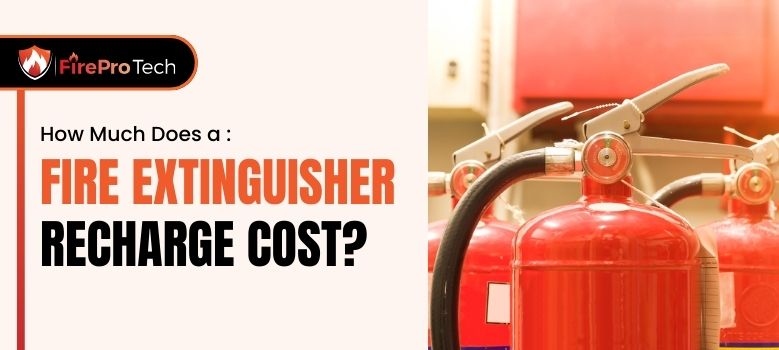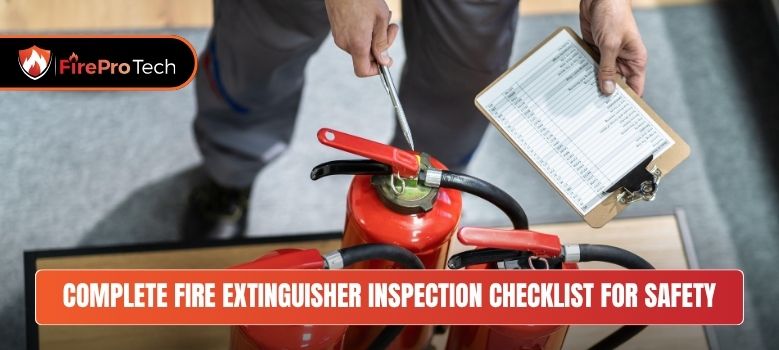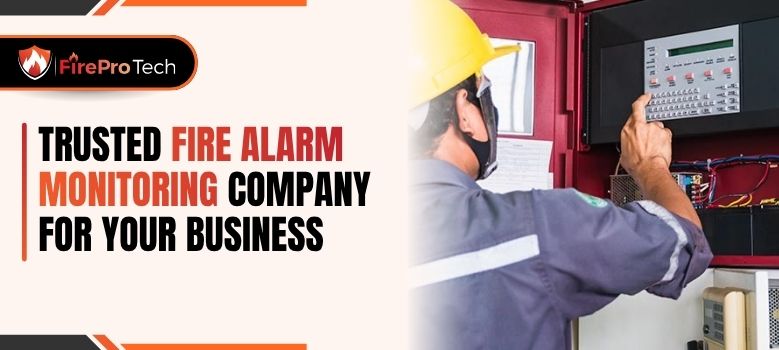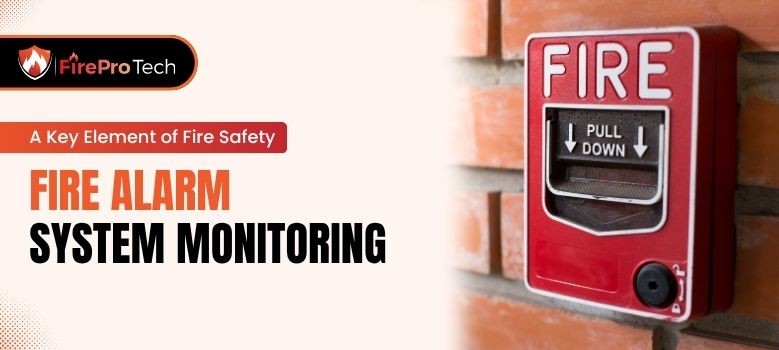
Fire extinguisher recharge is one of the most important steps in keeping workplaces, facilities, and public spaces safe from fire risks. While many business owners and property managers remember to install extinguishers, fewer realize that these devices require professional servicing to remain reliable. An extinguisher that has lost pressure, been discharged even briefly, or simply aged beyond routine inspection dates may fail when needed most. That is why understanding when and how to recharge is essential.
When a fire emergency strikes, every second matters. If the extinguisher does not discharge properly because it has not undergone a fire extinguisher recharge, lives and property are immediately at risk. Just like you would not drive a car without fuel or attempt to use a dead fire alarm, an extinguisher without the correct pressure and extinguishing agent is essentially useless. FirePro Tech, LLC provides complete extinguisher services to ensure your units stay ready for the unexpected.
This article explores what recharging entails, the costs involved, and how professionals handle the process. By the end, you will know not only why recharging is required but also how to choose the right partner to manage your fire safety equipment with confidence.
Recharging an extinguisher is not the same as simply topping off the contents. A professional fire extinguisher recharge includes depressurizing the unit, emptying remaining extinguishing agent, carefully inspecting all internal and external parts, refilling with the correct extinguishing agent, and repressurizing to the manufacturer’s specifications. The process is completed by applying a service tag and seal for compliance.
By contrast, refilling is just adding more agent, which does not guarantee the extinguisher is mechanically sound. Hydrostatic testing, on the other hand, is a more intensive procedure that checks the cylinder’s strength and integrity, usually required every 12 years or if there are concerns about damage. Understanding the difference is crucial for anyone budgeting for fire protection.
Even the smallest discharge is enough to require a fire extinguisher recharge. Releasing just a quick test burst lowers internal pressure, making the unit unreliable. Similarly, extinguishers flagged during routine fire inspections often need recharging. Technicians may find pressure gauge issues, valve leaks, or worn seals, any of which can compromise performance.
Another common trigger is time. Extinguishers that have sat unused for years are still subject to gradual pressure loss or internal corrosion. Regular inspections reveal when recharging is needed to bring them back into compliance.
Not all fire extinguishers are built to be recharged. Most commercial-grade models such as ABC dry chemical, CO₂, clean agent, and Class K are designed with metal valves and robust construction, making them suitable for repeated fire extinguisher recharge cycles. These units offer long-term savings and reliability when professionally serviced.
Disposable extinguishers, often identified by plastic valves and a “non-rechargeable” label, must be replaced after use or expiration. Attempting to recharge them is unsafe and noncompliant with fire codes. This distinction underscores why working with a trusted provider like FirePro Tech, LLC is essential—trained professionals know which units can be serviced and which require replacement.
Only certified professionals should handle fire extinguisher recharge. The process requires specialized equipment, precise refilling with manufacturer-approved agents, and compliance documentation for inspections and audits. An improper recharge can lead to catastrophic failure during an fire emergency lighting service.
Do-it-yourself attempts are not only ineffective but also potentially dangerous. Over-pressurization can rupture the cylinder, while under-pressurization leaves it unusable. Professional service ensures extinguishers are safe, compliant, and ready for deployment when needed most. FirePro Tech, LLC follows strict standards to guarantee your equipment meets every requirement for safety and performance.
Don’t Wait for an Emergency – Recharge Your Extinguisher
Understanding the cost of a fire extinguisher recharge helps business owners, property managers, and safety officers plan their fire protection budgets effectively. While it may seem like a simple task, the pricing varies depending on the extinguisher type, size, and the extent of service required. The cost reflects not only the extinguishing agent itself but also the labor, inspection, and certification processes necessary to keep the unit compliant.
FirePro Tech, LLC provides clear and transparent pricing so clients know what to expect. Because each extinguisher must be handled individually, there are multiple factors that influence the final charge. Below are the key considerations that shape the recharge cost.
The most direct factor is the type and size of the extinguisher. Smaller portable units, such as five-pound ABC dry chemical extinguishers, are typically less expensive for a fire extinguisher recharge than larger units used in industrial or commercial facilities. A ten-pound or twenty-pound extinguisher requires more extinguishing agent, more labor, and additional testing, all of which raise the price.
The extinguishing agent itself also matters. A basic dry chemical recharge costs less than a CO₂ or clean agent unit, which requires specialized handling and refilling processes. Class K extinguishers, used in commercial kitchens, involve higher costs due to their unique wet chemical solution and rigorous compliance requirements.
Beyond the agent and labor, recharging often includes additional materials. During service, technicians may replace discharge hoses, valve components, O-rings, or seals to ensure the extinguisher is safe. These parts are not always included in the base recharge price but are essential for long-term performance.
Compliance tags and service labels are another built-in cost. After a fire extinguisher each unit receives a new tag documenting the date, technician, and company performing the work. This recordkeeping is mandatory for inspections and adds a modest but necessary expense to the process.
Some providers may charge separately for services that go beyond the fire extinguisher recharge itself. Pickup and delivery fees can apply if a large number of extinguishers must be transported to a shop. Rush service, which prioritizes a recharge when an extinguisher is needed back in service immediately, can also increase costs.
Supplies such as safety caps, tamper seals, and shop materials may be itemized as well. FirePro Tech, LLC ensures that clients are informed upfront about these costs, helping them avoid unpleasant surprises. Transparent pricing allows businesses to understand exactly what they are paying for and why it matters.
For organizations managing large fleets of extinguishers, the cost of individual fire extinguisher recharge services adds up quickly. Schools, hospitals, warehouses, and office complexes often have dozens—or even hundreds—of units requiring service. In these cases, annual service agreements provide better value.
With a fire monitoring service plan, FirePro Tech, LLC schedules inspections and handles recharges as needed, spreading out costs and ensuring compliance across all units. This approach not only streamlines budgeting but also guarantees that every extinguisher is always ready for emergency use.
Choosing between a fire extinguisher recharge and a full replacement can sometimes feel like a balancing act between cost efficiency and safety. Both options are essential at different times, but understanding when to recharge and when to replace ensures compliance, extends equipment life, and helps maintain a responsible fire protection budget.
FirePro Tech, LLC helps clients make informed decisions by evaluating extinguisher condition, age, and service history. This professional guidance ensures that equipment remains dependable without unnecessary expenses.
In many cases, recharging is the most cost-effective option. If an extinguisher has been discharged but is otherwise in good condition, a fire extinguisher recharge brings it back to service at a fraction of the price of replacement. Commercial-grade extinguishers are designed for multiple recharges over their service life, making this the smarter long-term investment.
For example, a five or ten-pound ABC dry chemical extinguisher can often be recharged several times before reaching the end of its useful life. As long as the cylinder is structurally sound and passes inspection, recharging provides the same level of protection as a new unit.
There are times when replacement is the safer and more economical choice. If an extinguisher has physical damage such as corrosion, dents, or a failed pressure gauge, a fire extinguisher recharge may not restore full reliability. Disposable units, which are common in residential or small office environments, cannot be recharged at all and must be replaced once used or expired.
Another factor is age. Extinguishers approaching their twelve-year hydrostatic test date may be more cost-effective to replace rather than recharge, especially if they are older models without modern safety features. FirePro Tech, LLC evaluates each unit carefully to recommend the option that best safeguards both people and property.
Considering the long-term picture, it is important to think beyond a single service call. Extinguishers require maintenance at six-year intervals, including teardown and replacement of internal parts, along with a hydrostatic test every twelve years. These scheduled requirements influence whether continuing with a fire extinguisher recharge makes sense or whether a replacement is more practical.
By comparing the costs of repeated maintenance with the purchase of new equipment, business owners can plan ahead and avoid unexpected expenses. FirePro Tech, LLC works with clients to develop long-term strategies that balance safety and budget.
While it might seem straightforward to restore an extinguisher after use, the fire extinguisher recharge process is highly detailed and requires specialized tools. Learning how to recharge a fire extinguisher highlights why the procedure should never be attempted without proper training. This is why professional service providers handle every step, ensuring compliance with safety codes and manufacturer standards. FirePro Tech, LLC follows strict procedures to guarantee extinguishers are safe, functional, and ready to respond in an emergency.
The process begins with intake, where each extinguisher is logged, tagged, and prepared for a fire extinguisher recharge. Next, technicians carefully depressurize the unit to safely remove any remaining extinguishing agent. Once depressurized, the extinguisher is fully disassembled so each component can be inspected.
During teardown, professionals check the valve assembly, discharge hose, nozzle, and cylinder for wear or damage. Any part that shows weakness or corrosion is replaced to ensure performance and safety. This inspection step is critical, as even minor defects could cause the extinguisher to fail during use, which is why understanding how to recharge fire extinguisher units properly is essential to restoring full reliability.
After inspection, the extinguisher is refilled with the appropriate extinguishing agent—dry chemical, CO₂, clean agent, or wet chemical, depending on the unit. It is then repressurized to the manufacturer’s specifications using calibrated equipment. This ensures the fire extinguisher recharge restores the correct pressure level for reliable discharge.
Next, a leak test is performed to verify that seals and valves are secure. The extinguisher is weighed to confirm it contains the correct amount of extinguishing agent. Finally, the unit is labeled with a service tag, noting the date of recharge, the technician who completed the work, and the company responsible. This documentation ensures full compliance with fire codes and inspection requirements.
The time required for a fire extinguisher recharge varies depending on the type of extinguisher and the number of units being serviced. Small extinguishers may be recharged quickly, while large or specialized units may require more time. Businesses managing fleets often arrange for service rotation to avoid downtime.
Once recharged, the extinguisher is returned to its designated location with full documentation. FirePro Tech, LLC ensures that every serviced unit is tracked in compliance records, giving property managers confidence during audits and fire inspections. This professional handling eliminates guesswork and ensures readiness at all times.
Regulatory compliance plays a major role in determining how often a fire extinguisher recharge is required. Fire codes, insurance standards, and workplace safety regulations all demand that extinguishers remain ready for use at all times. Skipping or delaying service not only risks safety but can also lead to failed inspections and fines.
FirePro Tech, LLC ensures that every recharge is performed to exact standards and that all necessary documentation is provided. This makes compliance easier for business owners and facility managers who must demonstrate readiness during audits.
Fire extinguishers must be inspected regularly to remain compliant. Monthly visual checks confirm that the unit is in place, accessible, and shows no visible signs of damage. Annual professional inspections are more detailed, ensuring the pressure gauge, safety seals, and overall condition are within acceptable limits.
At the six-year mark, a more extensive maintenance procedure is required, which includes teardown and replacement of key internal parts. Every twelve years, extinguishers must undergo hydrostatic testing to ensure the cylinder is structurally sound. A fire extinguisher recharge often coincides with these scheduled milestones, ensuring the unit is safe and compliant.
After every fire extinguisher recharge, service providers must affix a tag or label indicating the date of service, the company performing the work, and the name of the technician. This tag serves as official proof for inspectors and auditors that the extinguisher has been serviced according to code.
In addition to tags, detailed service reports are often provided. These records help facility managers keep track of which units were serviced, what issues were corrected, and when the next inspection is due. FirePro Tech, LLC supplies this documentation with every service, simplifying compliance for clients managing multiple extinguishers.
A recharge appointment often uncovers problems that are not immediately visible during basic inspections. Corroded cylinders, weakened hoses, leaking valves, or clogged discharge nozzles are all issues that can compromise performance. These deficiencies must be corrected before the extinguisher can be returned to service.
Certified technicians address these issues by replacing damaged parts, resealing valves, and verifying that the unit holds proper pressure. By correcting deficiencies during a fire extinguisher recharge, the extinguisher is restored to full compliance and ready for safe use.
Get Your Fire Extinguisher Recharged – Stay Safe & Save!
Not all fire extinguishers are built the same, and that means the cost of service can vary significantly. The type of extinguishing agent and the size of the cylinder both influence how much a fire extinguisher recharge will cost. Understanding these differences helps property owners and managers make informed decisions about budgeting and long-term planning.
FirePro Tech, LLC provides clear cost breakdowns for different extinguisher types, ensuring clients know what to expect before service begins.
ABC dry chemical extinguishers are among the most common and generally the least expensive to recharge because the agent and servicing process are straightforward. CO₂ extinguishers, however, require specialized handling and refilling equipment, which increases cost.
Clean agent extinguishers, often used around sensitive electronics or in data centers, demand precision recharging with approved agents, making them more expensive. Class K extinguishers, designed for commercial kitchen hood cleaning services, involve a unique wet chemical solution that also adds to the service cost. Each extinguisher type comes with distinct recharge requirements that impact both price and turnaround time.
Smaller extinguishers, such as two- or five-pound models, are quicker and less costly to service. Larger extinguishers, ranging from ten pounds to industrial units over twenty pounds, require more agent and additional labor. This naturally increases the fire extinguisher recharge cost and raises common questions such as how much does it cost to recharge a fire extinguisher for different unit sizes.
For facilities managing fleets of different sizes, this difference can add up quickly. FirePro Tech, LLC evaluates each extinguisher by size and type, providing accurate estimates so clients can budget effectively.
Where an extinguisher is used also affects cost. Units installed in harsh environments such as industrial plants, grease-heavy kitchens, or outdoor spaces often experience more wear. This means more frequent recharges and a higher chance of part replacement during service.
Specialized extinguishers designed for these environments, such as Class K or clean agent models, also cost more to recharge due to their unique agents and safety requirements. By factoring in these environmental considerations, FirePro Tech, LLC helps clients plan for long-term maintenance expenses while ensuring complete protection.
Finding the right partner for a fire extinguisher recharge is about more than convenience. This service directly impacts workplace safety and compliance, making it essential to work with a company that is both qualified and dependable. The wrong provider may cut corners, skip important steps, or fail to provide documentation required for inspections. The right partner, however, ensures every extinguisher is safe, certified, and ready for use.
FirePro Tech, LLC offers reliable and professional fire extinguisher services, giving clients peace of mind that their equipment will perform properly in an emergency. For those searching for a fire extinguisher recharge company near me, knowing what to look for when selecting a provider can help narrow choices and prevent costly mistakes.
The first step in choosing a fire extinguisher recharge provider is confirming credentials. Reputable companies hold proper licensing and certifications that prove they are qualified to perform recharges in compliance with national fire codes. Insurance coverage is equally important, as it protects clients against liability if something goes wrong during service.
Without these verifications, there is no guarantee the recharge will meet compliance standards. Working with a certified company such as FirePro Tech, LLC eliminates these risks and provides assurance of quality workmanship.
Another important factor is service scope. Many businesses cannot afford downtime while their extinguishers are being serviced. Providers that offer pickup and delivery, loaner units, or after-hours appointments make it easier for businesses to stay protected without disrupting operations.
FirePro Tech, LLC tailors services to client needs, including accommodating emergency calls when extinguishers must be returned to service quickly. This flexibility ensures that safety is never compromised, regardless of scheduling challenges.
Pricing transparency is critical. Some providers add hidden charges for tags, seals, or testing, which can quickly inflate the cost of a recharge. A trustworthy company provides detailed quotes that explain exactly what is included.
At FirePro Tech, LLC, all costs are discussed upfront, including any additional parts or services that may be required. This open communication helps clients budget more effectively and ensures there are no surprises when the invoice arrives.
While many providers offer fire extinguisher recharge, FirePro Tech, LLC stands out by delivering comprehensive service, strict compliance, and unmatched customer support. Businesses that partner with the company receive more than just a recharge—they receive full-cycle fire protection management tailored to their needs.
FirePro Tech, LLC offers more than a single service. From monthly and annual inspections to full maintenance and hydrostatic testing, the company provides complete fire extinguisher support. Each recharge is part of a larger maintenance strategy that ensures long-term reliability.
Clients benefit from having a single trusted provider manage all aspects of their fire protection equipment. This eliminates the need to coordinate with multiple vendors and ensures consistency across every service performed.
The quality of parts and procedures used in a fire extinguisher recharge makes a direct difference in performance. FirePro Tech, LLC uses original equipment manufacturer (OEM) parts and follows strict service standards. Every recharge includes detailed documentation to support compliance with fire codes and inspection requirements.
This attention to detail means clients can pass audits with confidence, knowing their extinguishers are fully certified and ready for use. The combination of quality workmanship and transparent recordkeeping sets the company apart from other providers.
For businesses managing multiple sites or large fleets of extinguishers, scheduling and coordination can be challenging. FirePro Tech, LLC simplifies this process by offering flexible scheduling and streamlined fleet management solutions. Extinguishers across multiple locations are serviced in a structured, organized way to reduce downtime and eliminate missed compliance dates.
This approach ensures that all units remain in service and compliant at all times, giving facility managers one less responsibility to worry about. By partnering with FirePro Tech, LLC, businesses gain not only reliable service but also peace of mind that their fire protection strategy is handled by professionals.
Fire extinguisher recharge is more than just a maintenance task—it is a critical part of keeping people, property, and businesses safe. An extinguisher that is not serviced properly could fail at the worst possible time, turning a small incident into a major emergency. By understanding the costs, the process, and the differences between recharging and replacement, business owners and facility managers can make informed choices that protect both safety and budgets.
Working with a trusted provider ensures every extinguisher is handled according to code and manufacturer standards. FirePro Tech, LLC delivers this assurance through complete inspection, maintenance, recharge, and testing services. Whether you manage a single office or multiple facilities, professional fire extinguisher service keeps your team prepared and your property protected.
The cost varies depending on the extinguisher type, size, and condition. Smaller dry chemical units are generally less expensive, while specialized extinguishers such as CO₂, clean agent, or Class K require higher costs due to the agents used and the labor involved. Additional parts, compliance tags, and testing may also affect pricing. FirePro Tech, LLC provides transparent quotes so clients know exactly what to expect when scheduling a fire extinguisher recharge.
In most cases, recharging is more cost-effective, especially for commercial-grade extinguishers that are designed for multiple service cycles. Replacement becomes a better option when the extinguisher is damaged, disposable, or nearing mandatory hydrostatic testing. FirePro Tech, LLC helps clients evaluate each unit and provides expert guidance on whether a recharge or replacement offers the best value for safety and compliance.
Fire extinguishers should be professionally inspected at least once a year, with monthly visual checks performed in-house. Recharging is required after any discharge, even a small test burst. Extinguishers also require teardown service every six years and hydrostatic testing every twelve years. FirePro Tech, LLC ensures each unit is maintained according to these intervals and provides documentation to keep clients compliant with fire codes.
Not all extinguishers are built for recharging. Commercial-grade models with metal valves are typically rechargeable, while disposable units with plastic valves are designed for single use and must be replaced after discharge or expiration. Attempting to recharge a disposable unit is unsafe and noncompliant. FirePro Tech, LLC identifies which extinguishers can be serviced and which require replacement.
Professional recharging services are available through certified fire protection companies. FirePro Tech, LLC provides comprehensive recharge services, including pickup, on-site inspections, and loaner units if needed. Choosing a local, certified provider ensures your extinguishers are properly serviced and compliant with all applicable safety codes.
The turnaround time depends on the extinguisher type and the number of units being serviced. Small portable extinguishers can often be recharged the same day, while larger or specialized units may take longer. For businesses managing fleets, service schedules can be arranged to minimize downtime. FirePro Tech, LLC offers flexible options, including emergency calls, to ensure extinguishers are returned to service promptly.
Most fire departments do not provide this service to the public. Recharging requires specialized equipment, certified agents, and compliance documentation that fire protection companies are trained to provide. FirePro Tech, LLC is equipped to handle all aspects of fire extinguisher recharge, giving clients confidence that their extinguishers are serviced to the highest standards.
Refilling typically means adding extinguishing agent back into a unit, while recharging is a complete process that includes depressurizing, inspecting, replacing worn parts, refilling, repressurizing, and leak testing. Only recharging ensures the extinguisher is fully functional and compliant. FirePro Tech, LLC performs complete recharges rather than simple refills to guarantee safety and reliability.

A strong fire extinguisher inspection checklist is the foundation of a safe, compliant, and well-prepared...

A trusted fire alarm monitoring company plays a critical role in keeping your business protected...

Fire alarm system monitoring is one of the most critical layers of modern fire protection....